› Forums › General Discussion › Betelgeuse
Tagged: Betelgeuse Leona occultation
- This topic has 97 replies, 23 voices, and was last updated 5 months ago by
 Robin Leadbeater.
Robin Leadbeater.
-
AuthorPosts
-
14 February 2020 at 10:37 pm #582031
 Robin LeadbeaterParticipant
Robin LeadbeaterParticipantYes slightly as seen in the increased depth of the molecular absorption bands (perhaps 1 subdivision eg M2i to M3i?)
https://britastro.org/comment/7649#comment-7649
https://britastro.org/comment/7861#comment-7861
Interestingly there has also been a reduction in H alpha absorption since the start of the year
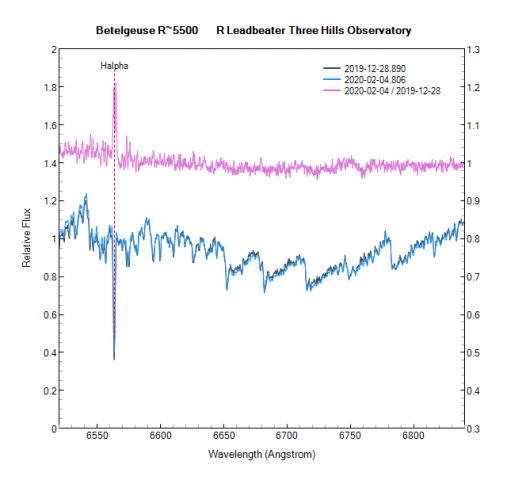 15 February 2020 at 10:24 am #582033
15 February 2020 at 10:24 am #582033 Alan ThomasParticipant
Alan ThomasParticipantDust does seem to be one possibility –
Alan
15 February 2020 at 8:28 pm #582034 Robin LeadbeaterParticipant
Robin LeadbeaterParticipantChristian Buil has just posted some high (R ~ 38,000) resolution spectra which confirm the reduction and narrowing of the H alpha line seen in my medium resolution spectra. He also detects a small (4.5km/s) shift in the line.
http://www.spectro-aras.com/forum/viewtopic.php?f=38&t=2433&p=13796#p13792
These observations may be consistent with the partial obscuration of the star as suggested from the VLT images. The speed of rotation of the star is of the right order as can be seen in this reference and the axis of rotation is given there
https://www.obspm.fr/the-slow-rotation-of-the-red.html?lang=eng
As far as I can see, the orientation of the VLT image is not given though unfortunately.
Jeremy, are you still in contact with Prof. Constantino Sigismondi? I wonder if these observations might be of interest
Cheers
Robin
23 February 2020 at 9:14 am #582046 Andy WilsonKeymaster
Andy WilsonKeymasterAn astronomers telegram has been issued as Betelgeuse started to brighten again in mid February. This appears consistent with the existing variability cycles though a deeper minimum than usual, probably due to overlapping cycles. It is still interesting and useful to observe with both photometry (visual and electronic) and spectroscopy. To verify the brightening continues as expected and to obtain more data on the behaviour on this interesting star.
2 March 2020 at 4:34 am #582070 Jeremy ShearsParticipant
Jeremy ShearsParticipantThere is an excellent article by Mark on “Supernova Betelgeuse?” on page 10 of the current VSS Circular. Well worth a read!
The star has been gradually brightening since mid Feb and is currently magnitude 1.4. Do keep on observing it until the end of the season.
3 March 2020 at 6:28 am #582071 Jeremy ShearsParticipant
Jeremy ShearsParticipantA couple of weeks ago I shared some thinking from Constantino Sigismondi about the current fade of Betelgeuse. He’s written a piece on the recent events from both a professional and an amateur perspective. You can read it in the March edition of AGB News, lower half of page 1 to page 2.
4 March 2020 at 5:06 pm #582072 Robin LeadbeaterParticipant
Robin LeadbeaterParticipantThe spectrum looks to have returned to how it was at the start of the year
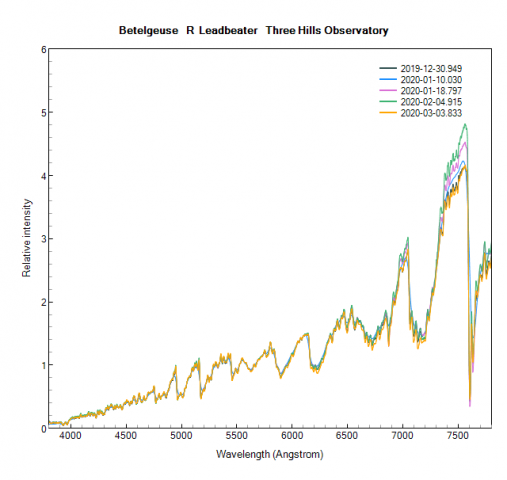 9 March 2020 at 10:02 am #582089
9 March 2020 at 10:02 am #582089 Dr Andrew SmithParticipant
Dr Andrew SmithParticipantAn interesting paper from Emily Levesque and Phil Massey https://arxiv.org/abs/2002.10463 who propose ” …that episodic mass loss and an increase in the amount of large-grain circumstellar dust along our sightline to Betelgeuse is the most likely explanation for its recent photometric evolution”
Regards Andrew
9 March 2020 at 10:42 am #582090 Robin LeadbeaterParticipant
Robin LeadbeaterParticipantI Iooked at this but their claim that the extinction is grey is not the case here if one looks at the photometry in the IR where there was no reduction in H J bands and a smaller drop in R compared with B,V which is also seen in spectra. Perhaps this can be explained by the large grained dust model but I am surprised they have not considered the available photometry data
9 March 2020 at 11:04 am #582091 Robin LeadbeaterParticipant
Robin LeadbeaterParticipantI see their spectra stop at 6700A before the larger changes in the spectrum become obvious
9 March 2020 at 11:15 am #582092 Dr Andrew SmithParticipant
Dr Andrew SmithParticipantStrange indeed Robin, and suprising as the are both experts on red supergiants. Indeed EML has written a book on the astrophysics of Red Giants!
Maybe the IR bands are more sensitive to Teff than in the V . I will look at her book and see if I can find any comment on it.It will be interesting to see how the discussion develops.
Regards Andrew
9 March 2020 at 11:19 am #582093 Dr Andrew SmithParticipant
Dr Andrew SmithParticipantIn any event I found their discription of how the did the Spectrophotometry interesting.
Regards Andrew
12 April 2020 at 6:19 pm #582271 Hugh AllenParticipant
Hugh AllenParticipantI’ve continued to follow the evolution of the spectrum of Betelgeuse, taking advantage of this quite incredible run of clear weather. My last observation was on Thursday evening with Betelgeuse at an altitude of about 30deg as it just about got dark enough – I think this could be my last reliable observation before it disapppears into twilight.
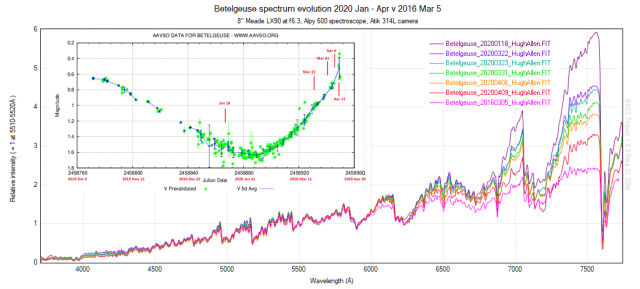
The deep fade in January corresponded with a significant increase in relative brightness in the near infrared which is now declining back to the state in my spectrum of 2016 Mar 5 when the V mag was also near the current ~0.5. To ensure reliable response correction in the shape of the spectra I captured the nearby B5V star HD 36267 from Francois Teyssier’s Reference Star Finder; it has a low E(B-V) extinction of 0.03 and so the B5-7V Pickles reference spectrum can be used to give an accurately response corrected Betelgeuse spectrum right out to 7740Å. To avoid any scintillation effects I defocused the image of Betelgeuse on the spectroscope slit to allow 30sec exposures without oversaturating the spectrum image in the camera. It’s been an interesting episode for spectroscopy.
Hugh
P.S. I’ve also added the spectra comparison as an attachment for legibility
13 April 2020 at 4:02 pm #582275 Robin LeadbeaterParticipant
Robin LeadbeaterParticipantHi Hugh,
Nice series !
I tried to merge your spectra with mine as they appeared to show the same trend but ran into difficulties intially. I then compared our spectra on similar dates and saw some differences in the continuum shape (Perhaps due to different technique. To beat down the scintillation I summed multiple short exposures rather than defocus and I used a different reference star HD36777). No matter though as the ratio is consistent so it should be possible to reconcile our two series of spectra and combine them to give full coverage from before minimum
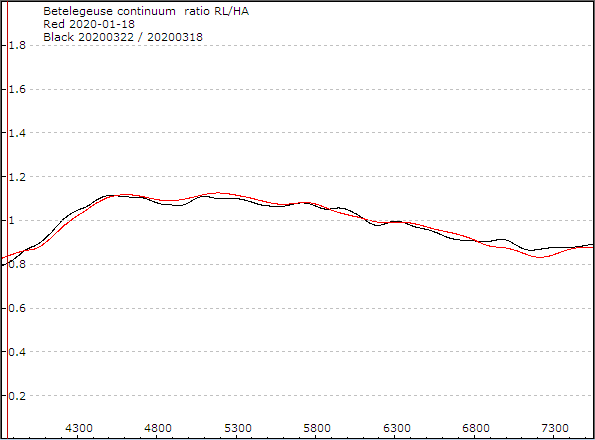 18 June 2020 at 9:05 am #582647
18 June 2020 at 9:05 am #582647 Dr Andrew SmithParticipant
Dr Andrew SmithParticipantA different take on the dimming: https://arxiv.org/abs/2006.09409
“Betelgeuse is the nearest Red Supergiant star and it underwent an unusually deep minimum at optical wavelengths during its most recent pulsation cycle. We present submillimetre observations taken by the James Clerk Maxwell Telescope and Atacama Pathfinder Experiment over a time span of 13 years including the optical dimming. We find that Betelgeuse has also dimmed by sim20% at these longer wavelengths during this optical minimum. Using radiative-transfer models, we show that this is likely due to changes in the photosphere (luminosity) of the star as opposed to the surrounding dust as was previously suggested in the literature.”
Regards Andrew
19 June 2020 at 11:59 am #582658 Roy HughesParticipant
Roy HughesParticipantPuzzled by sim20% in the quote I looked at the .pdf and it’s ~20%
got it now.
20 June 2020 at 3:19 pm #582667 Dr Paul LeylandParticipant
Dr Paul LeylandParticipantsim is the LaTeX markup for the ~character. Likewise % for %, because % has a mark-up meaning in LaTeX.
3 September 2020 at 10:19 am #583075 Jeremy ShearsParticipant
Jeremy ShearsParticipantThe current VSS Circular contains an article by Drs Chris Lloyd and Mark Kidger which reports that recent observations of Betelgeuse, after its summer conjunction, reveal that the star started to fade almost immediately after recovering from its historic fade last season.
An Astronomers Telegram a few days ago by Costantino Sigismondi and his team suggests that “a second dust cloud ejected by the star is passing over its photosphere along our line of sight”.
As Betelgeuse is now becoming visible, further observations are encouraged.
Don’t forget that you can also catch up on Mark Kidger’s excellent webinar on Betelgeuse on the BAA YouTube channel.
3 October 2020 at 11:47 am #583201 Jeremy ShearsParticipant
Jeremy ShearsParticipantThere is an article on “A Year of Betelgeuse“ in the October edition of The AGB Newsletter:
https://www.astro.keele.ac.uk/AGBnews/issues/AGB279.pdf
Emily Levesque (U of Washington) discusses what the recent dusty dimming might mean for other red supergiants, On page 3 to 4
14 December 2021 at 10:15 am #585015 Jeremy ShearsParticipant
Jeremy ShearsParticipantI can’t believe it’s 2 years since the great dimming of Betelgeuse. The latest light curve was shown in the recent Christmas Meeting Sky Notes by Nick James. There have been a couple of conferences dedicated to Betelgeuse in the last year. Here is a nice paper on “The curious case of Betelgeuse”, by Jacco van Loon (Keele U.) posted in ArXiv today.
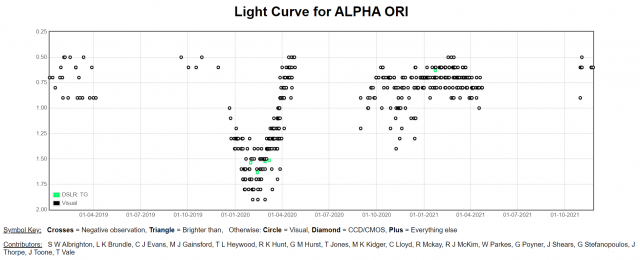
-
AuthorPosts
- You must be logged in to reply to this topic.
